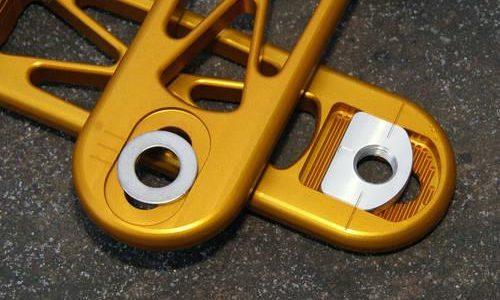Are road bikes faster than hybrid bikes? One would tend to think so instinctively. The words “road bike” evoke professional racing and the Tour de France, and those skinny guys are seriously fast. But why is that?
What makes the difference between those two types of bicycles? Perhaps to the untrained eye, there are more similarities than discrepancies. After all, they both have 700C wheels mounted under a tubular frame compliant with UCI’s quintessential diamond shape. But there’s way more to it.
Let’s delve into the technicalities, from the most evident to the lesser-known, of what causes road bikes to be faster and more suited to racing than hybrid bicycles.
Weight
Let’s start with one of the most obvious even for observers out of the cycling sport – the weight. This is a characteristic of the bike hugely influential on the speed, particularly when going uphill.
There are a lot of factors that play into shaping a light or heavy bike build but as a general rule road bikes tend to feature lighter materials and components than hybrids.
Road bike frames are increasingly being constructed with carbon fiber composites while hybrid frames still favor durability, although with a slight weight penalty of the aluminum or even steel.
Other components like handlebars, stems, seat posts, and even wheels usually follow suit regarding the material choices.
Stiffness
Very much linked to the frameset material of choice, the stiffness of the bike is in direct proportion with the ability to transmit power efficiently onto the pedals and down to the road.
With modern carbon fiber frames, the high stiffness to weight ratio guarantees that more of the rider’s total power output is applied to generating movement.
Typical hybrid bike’s materials such as aluminum or steel are more supple and don’t allow for such an efficient power transmission resulting in a marginal speed loss.
Geometry and aerodynamics

The geometry of the frame is probably the most overlooked yet highly influential factor that makes road bikes aerodynamically faster than hybrids.
In normal circumstances, the body mass of the rider accounts for almost 90% of the aerodynamic drag produced while riding, with the bicycle being responsible for a mere 10%. Then, why is bike geometry so important? Let’s take a look at two crucial measurements of a bicycle frame to discover the reason.
The “stack” is the vertical measurement from the center of the bottom bracket to the top of the head tube, while the “reach” is the same measurement in horizontal. Hybrid bikes tend to have a higher stack and shorter reach, resulting in a more upright position and comfortable ride.
On the contrary, road bikes have a more aggressive geometry with a shorter stack and longer reach that allow the rider to adopt a lower and more stretched position over the bike.
It isn’t hard to imagine that the leaned forward riding position of a road bicycle frame will reduce the frontal area of the rider thus resulting in lower aerodynamic drag. Lower drag at equal power output means more speed, hence the road bike geometry will always make the rider faster than the hybrid bicycle geometry.
Bars (drop vs flat)
Handlebars are possibly the most obvious visual difference between a road bike and a hybrid bike but apart from the looks it massively influences aerodynamics which, as we already know, results in a large speed differential. Hybrid bikes are equipped with wide flat bars, intended to provide comfort and greater control at lower speeds while forcing the rider to adopt a wide position with open arms and shoulders that is not precisely aero-friendly.
Road bikes favor another type of handlebar, the drop bars. These are typically narrower, lower, and allow the rider to tuck shoulders and arms into a more aerodynamically efficient (and faster) position.
Gear ratio
 This is more of a consequence rather than a cause of road bikes being faster than hybrids. It is because hybrid bicycles are intended to provide a more comfortable ride on all terrains, the gear ratios mounted on hybrids’ drivetrains are significantly smaller than those typical of road bikes, thus allowing for higher cadences (easy pedaling) at lower speeds.
This is more of a consequence rather than a cause of road bikes being faster than hybrids. It is because hybrid bicycles are intended to provide a more comfortable ride on all terrains, the gear ratios mounted on hybrids’ drivetrains are significantly smaller than those typical of road bikes, thus allowing for higher cadences (easy pedaling) at lower speeds.
As an example, the biggest gear you can ride on a hybrid is a 45Tx11T while some road bikes are equipped with up to 53Tx11T. Provided that you can turn the pedals at the same cadence the speed difference between those two gear ratios will be 8.5 km/h faster on the road bike.
Tires
Road bicycles have always been equipped with skinnier tires than other types of bikes such as MTB or hybrids. The key reason behind this tire choice lies in reducing the rolling resistance generated between rubber and asphalt thus increasing speed.
Studies have shown that the optimal tire widths to reduce rolling resistance to a minimum on the tarmac are between 25 and 28 mm, a modern standard road tire width. Hybrid bikes typically mount wider tires up to 40 mm in width, sacrificing the speed in exchange for a more comfortable bump-absorbing ride feel.
A different purpose
Based on the above series of characteristics and factors we can undoubtedly conclude that road bicycles are faster than hybrid bikes. However, this doesn’t mean that both types of bikes pursue the same objective of pure speed. In fact, they have clearly different purposes.
Hybrid bikes are designed with comfort and utility in mind. They are day-to-day durable machines that can tackle most terrains with ease: from a city commute through steep alleys to a back roads excursion over gravel paths.
In contrast, road bikes are pure performance machines whose sole purpose is to get from point A to point B faster, provided that the surface in between is tarmac, and deliberately disregarding comfort and convenience.
Comparing these two types of bikes using speed as the key factor will throw some light upon a purchase decision based solely on sporting performance, but there are still other variables such as convenience and usability to be taken into account by many prospective bicycle buyers.

Road cyclist, adventure traveler and graphic designer based in South East Asia, and working for international brands such as SpiceRoads Cycling and The Pedla.


